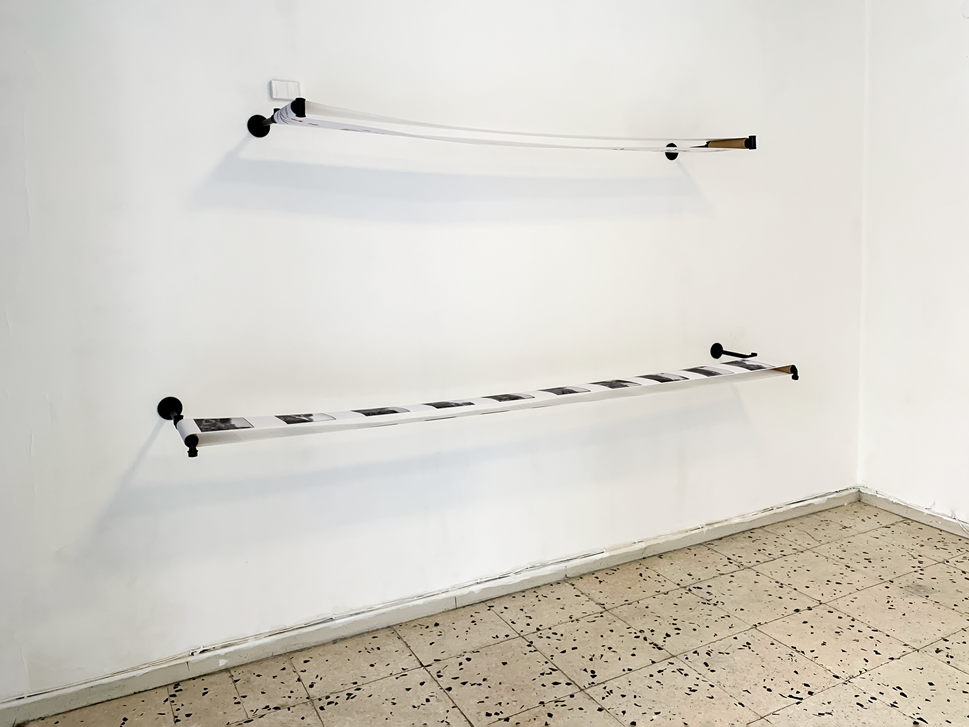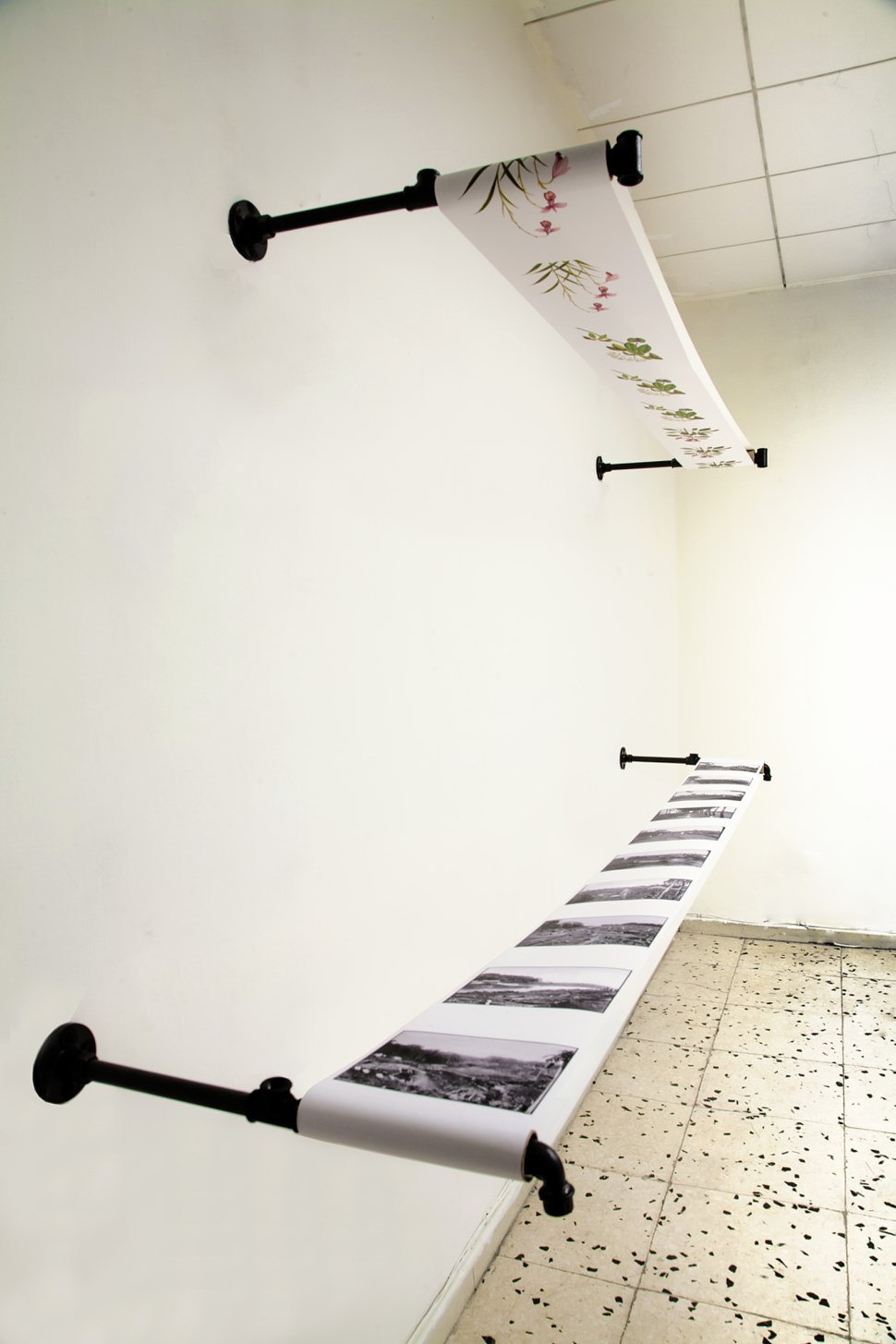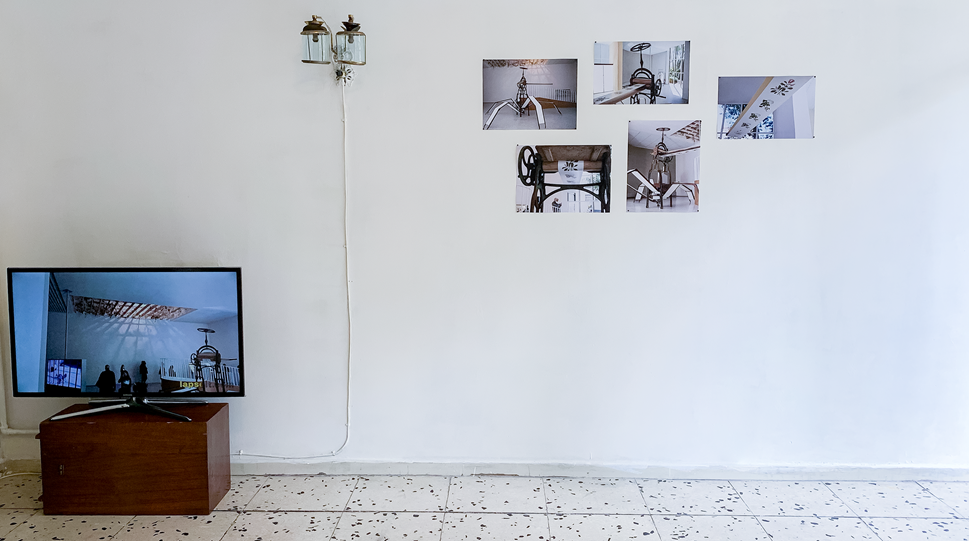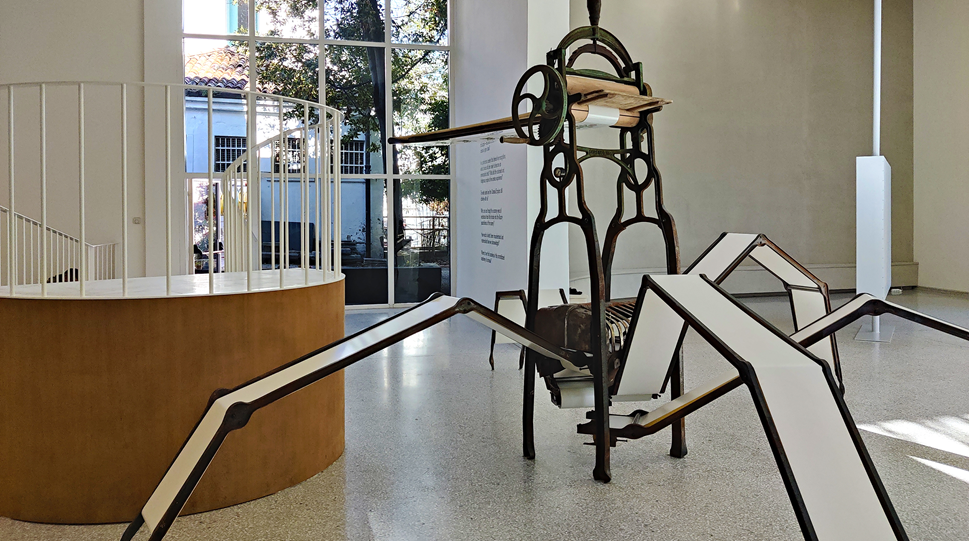Interview with Bita Razavi and AmirAli Ghasemi on Razavi's Installation at the 59th Venice Biennale
17 Jul 2022Interviewer: Nafiseh Saleh Abadi
"Room for Doubt" located at North Kheradmand Street, Tehran, hosted an exhibition by Bita Razavi titled "Erased Images of a Work About Historical Erasure" from April 28 to May 5, 2022. The exhibition dealt with the censored part of Razavi's installation simultaneously displayed in Estonian Pavilion at the 59th Venice Biennale and provided the Iranian visitors with an opportunity to see parts of the installation that were erased from the exhibition of the Estonian Pavilion. By putting the documentation video of the installation in Venice next to the installation of erased images presented at Room for Doubt – one could put the puzzle together and imagine the complete work.

Bita Razavi, Erased Images of a Work About Historical Erasure (2022), Installation view, Room for Doubt, Tehran. Photo: Mahsa Hosseini
On the left wall of the gallery, the viewer can see the missing parts of the kinetic sculpture called "Kratt - Diabolo №3" currently displayed at the Estonian Pavilion, which according to the artist is inspired by a mythical creature in Estonian folklore. The upper section of this giant sculpture which consists of several belts and rollers produces different botanical drawings on a white background. On the ground level, the white belts or legs of the sculpture expand in different directions. These belts were originally designed to display a series of archival photographs showing the destruction of indigenous landscapes and exploitation of resources in the Dutch East Indies, but they were left out from the exhibition and in a place miles away from the original installation, have grown out of the walls of Room for Doubt. On the opposite wall, some images of the original installation are displayed. Next to them a timelapse video appears and reappears on a screen, showing an overall view of the Estonian Pavilion at the Venice Biennale and its audience.
Bita Razavi (b. 1983 - Tehran) is an Iranian artist living in Finland and Estonia. She received her music degree from the Art University of Tehran and studied fine arts at the Finnish Academy of Fine Arts. Her works have been exhibited at the Tehran Museum of Contemporary Art, the first Trondheim Biennale, Finnish Museum of Photography, Helsinki Photography Biennale, Helsinki Design Museum, and National Art Museum of Ukraine, etc. Regarding the recent exhibition of Bita Razavi's works at the 59th Venice Biennale and in order to find out more about the installation, which includes several historical and cultural references, we interviewed Bita Razavi and Amirali Ghasemi, the director of New Media Projects and the curator of "Erased Images of a Work About Historical Erasure".
- Could you please explain the project and its nature?
Amirali Ghasemi: Estonian Pavilion features two artists, and one of them is Bita Razavi, the Iranian artist living between Finland and Estonia. Visitors can start viewing Razavi's installation at the entrance of a pavilion that, in fact, belongs to the Netherlands and is named after its architect, Rietveld. At the entrance, a guide with a special uniform welcomes the visitors and leads each one of them through different entrances. Eventually, one of these entrances opens to a platform that has a close view of the upper part of the kinetic sculpture called Kratt - Diabolo №3, which is a symbolic printing press. So different people enter through different doors and access different parts of the installation. This is inspired by colonial architecture, where workers and servants are separated from elites and masters. On the upper belt of the machine, a series of botanical paintings are visible, which belong to the nineteenth-century Estonian artist Emilie Rosalie Saal, whose life story has been the basis of the exhibition of the Estonian Pavilion, "Orchidelirium - An Appetite for Abundance". Visitors facing the upper part of the installation can have a closer look at these images and move the belts on which the paintings are printed. At the Venice Biennale, the images of the bottom part of the installation are censored and replaced with white belts. These belts were supposed to accommodate photographs of Dutch East Indies, including photographs of the Saals' rubber plantation owned by Emilie Saal's spouse, who worked for the Dutch army as a topographer. The images divulged Dutch activities such as logging trees, damaging the natural vegetation, and manipulating the landscape in colonized lands. The sculpture is about four meters high and comprises different parts of old apparatuses. It is also inspired by a mythological creature in Estonian folklore called Kratt. According to this myth, when the owner of the Kratt endowed the devil with three drops of blood, Kratt came to life and carried out the tasks efficiently, and when it didn't have anything to do, it could hurt its master. It is a metaphor for a machine that has to work continuously; otherwise, it would revolt against its owners. It is also essential to know the other elements of the installation; An elevated platform made of teak wood and marble, and the other element of the installation is a hanging garden with artificial plants and artificial light, which simulates a natural day cycle from sunrise to sunset in only ten minutes.
Bita Razavi: The exhibition of the Estonian Pavilion is inspired by the biography of Estonian botanical painter Emilie Rosalie Saal (1871 – 1954) who moved from Estonia, back then under the Russian Empire, to Indonesia, then Dutch East Indies, a colony of the Netherlands. She managed to pursue a career as an artist and become part of the elite circle of the Dutch thanks to her Europeanness, skin color, and the position of her husband in the Dutch army. For me, it was crucial to shed light on the consequences and expenses of her social climbing and the consequences of Western practice of botanical illustration of the exotic land to which Emilie dedicated her life. Also, her practice would never become possible without the labor of dozens of local servants who worked at their household and plantation sites. My kinetic sculpture Diabolo № 3 deals with this complex relation and was supposed to symbolically print Emilie's drawings on the upper part and the consequences and dark background of her practice on the lower belts. But unfortunately, the lower images got censored and didn't appear in the exhibition. In my opinion, veiling the dark background of such a success story is historical erasure.
- It is mentioned in the short statement that these images, which are being displayed at the Room for Doubt in Tehran, have been excluded from the Venice show due to the pressure of the Estonian Pavilion curator. Could you please explain more about the details and the reason for this censorship?

Bita Razavi, Erased Images of a Work About Historical Erasure (2022), Installation view, Room for Doubt, Tehran. Photo: Amirali Ghasemi
Amirali Ghasemi: The reason for erasing these images might have been that showing the images of Indonesians in a European context by Europeans may be considered cultural appropriation. The images display the dark aspects of an apparently positive, success story and botany. So, the lower belts of the installation are now blank. Through a conversation with the artist, we came to the conclusion that we needed to organize a series of events to make these censored images available to the public; so, we started with displaying them in Tehran and it will continue to different venues in Helsinki, Amsterdam, Vienna, and several other cities. It will keep traveling during the Biennale until the installation is shown its finalized and planned form.
I suppose the real reason for such a happening could be that there was no counter institutional power to prevent censorship, a big part of the exhibition budget came from the curator's institution. Artists are not in a strong position when it comes to institutional power games. Excluding this part of the installation has turned this conceptual project into a decorative one. What has become an area of conflict between the artist and the curator is how far an artist is allowed to use archival images responsibly, but not profitably, to address an issue about another geographical location. This was probably conservative censorship aiming to hide the dark sides of Dutch colonialism history and to ensure that anything presented and published is safe and immune from criticism.
Bita Razavi: The main problem was the lack of curatorial direction which led to many unnecessary and hysteric last-minute changes including the erasure of this work. The curator of the Estonian Pavilion is an academic with very limited experience in curating, particularly working with living artists and commissioned works. The whole two-year process of this project was affected by inconsistent decisions and doubts and worries. The exhibition she was trying to put together wasn't an honest one; it was a safe and superficial show following current trends of contemporary art such as colonialism and ecocriticism and it was extremely important for her to do everything according to the rules of political correctness just to be completely safe from criticism. What she didn't consider was that most of these rules are written by the West and from the Western perspective, and they might not necessarily apply to me.
A couple of months before the opening, the curator and the other artist of the exhibition became very concerned about being criticized for making an exhibition about the colonial experience of Indonesia as white Europeans. Not only she pressured the commissioner to remove the images of my sculpture, but she also attempted to remove my other already produced and installed work called "Elevated Platform" with the explanation that the work is a continuation of colonial practices. To give the impression that we have an Indonesian voice in our project, she invited an Indonesian artist to make a video for our exhibition a few weeks before the opening, when the works were being transported to Venice; last-minute cosmetic fixes damaged the entire exhibition dramatically and turned it into this didactic exhibition that it is now.

Bita Razavi, Kratt (2022), Kinetic sculpture, Close-up of the uncensored work. Photo: Anu Vahtra
- Is there any explanation provided for the visitors in the Estonian Pavilion regarding the erased parts of the installation?
Amirali Ghasemi: No, even though the Ministry of Culture, the commissioner, and all the members involved in the project know about the deleted parts, no explanation is provided for visitors.
Bita Razavi: Not at all, at least not until now. Although I have insisted that such information is necessary for understanding the work and should be available to all visitors, the commissioner has refused to include this information in the handouts of the exhibition and the press. Interestingly, the exhibition handout text describing this work still mentions that "the privileged visitors who gain access to the Elevated Platform have the chance to activate this printing machine if they accept its consequences." The word consequences refers to irreversible damages and destruction of landscape shown in the archival photographs that were supposed to be printed on the lower belts of the machine. Now that those images are censored, this description doesn't make any sense.
- Among all the artworks presented at the Venice Biennale by Iranian artists, Bita Razavi's work is selected to be presented at the Room for Doubt. Is there any reason for that besides showing the censored part?
Amirali Ghasemi: I have known Bita and her practice for several years, and we also collaborated in arranging a retrospective show at Lajevardi Foundation in 2015. My interest wasn't in presenting an artwork or artist exhibited at the Venice Biennale; our aim was to shed light on the censorship of this work. In general, national representation is an outdated format and nowadays twisted with issues like migration, colonization, etc. which questions the borders and geographical categorization. For me, the national representation principle of the biennale as competing in a sports tournament, such as the Olympics, undermines the purpose and nature of an art exhibition. For us, the most important part of the biennale on which we decided to focus was its power structures, which sometimes lead to censorship and erasure and manifest themselves in the form of control of the narrative and ideological power.

Bita Razavi, Erased Images of a Work About Historical Erasure (2022), Installation view, Room for Doubt, Tehran. Photo: Mahsa Hosseini
- Regarding the fact that Bita Razavi has worked and lived in different countries and cultures, why was she chosen to represent Estonia?
Amirali Ghasemi: As far as I know, the process of selection was through an open call and an international jury selected the project. In addition to her nine-year background of living and working in Estonia, Razavi spent four years renovating two houses in Estonia to study the Soviet renovation methods and materials throughout years of changing economic and political situations which resulted in her immersive installation "Museum of Baltic Remont". Fortunately, this time in the Estonian Pavilion, as an exception, artistic merits were considered more important than the artists' blood and race, just like Franco-Algerian artist Zineb Sedira, who represents France and had to leave the cultural sanction campaign against Israel to maintain her position. Also, Razavi has lived and studied in several countries and her experience might have been another reason for her selection. Of course, her own explanation would be more informative because this is just my personal speculation.
Bita Razavi: Although I'm mostly known as a Finnish artist, in 2013, I moved to Estonia for a few years, and since then I have lived between Finland and Estonia. I made several works that dealt with events of historic proportion in Baltic region from the perspective of an outsider, and in 2019 I was actively exhibited in Estonia. So, maybe it was a natural choice to invite me to join their team. Moreover, the protagonists of our story, Andres and Emilie Saal, were also world travelers and in depicting their story, perhaps my life experience and perspective were believed to be valuable.
The process of making exhibitions for the national pavilions in the Venice Biennale is extremely bureaucratic and, at its core, is an outdated institution. The exhibitions are official representations of each country and are organized by state funding and under the supervision of a commissioner chosen by the Ministry of Culture. Only some countries have fixed pavilions in the main venues of the Biennale, Giardini and Arsenale, and the rest of the countries rent venues in the city. This year was a historic opportunity for Estonia as the Netherlands decided to give their pavilion to Estonia, so, this national representation became extremely important for Estonia. An international jury was invited to choose the artists and the winning project to be exhibited. Altogether, I think this was a great decision to tackle the old-fashioned definitions of nationhood and national representation in the Biennale.

Bita Razavi, The designated Entrance (2022), Durational performative intervention, Estonian Pavilion at the 59th Venice Biennale. Photo: Bita Razavi
- The installation's statement in the Estonian Pavilion explains the 'Designated Entrances', and guards guiding the visitors to different entrances. In which aspects this performative procedure correlates with the nature of the installation? Or is there basically any connection between this selective visiting and the whole work?
Bita Razavi: The first thing the privileged audience of Giardini and Venice Biennale is confronted with is not being allowed to enter the Pavilion through the main entrance. The emblematic entrance of the pavilion is blocked by a performer/exhibition guard, addressing class divisions inscribed in the architecture of Estonian manor houses and Dutch colonial architecture in Indonesia, where the servant class is physically separated and made invisible by being obliged to use the back or side entrances. After that comes the division of the audience into two categories. When reading the Saals' biographies, the first thing that attracted my attention was the notions of class, access, and privilege. We often think of class as something assigned to people—each person is born with a set of privileges. But how much is it possible to tackle these assigned privileges, and how much choice is involved? The Saals improved their social class by moving to Indonesia and adopting the colonizer's lifestyle. They climbed the ladder—or the colonial hierarchy—when Andres made a choice to work for the Dutch East Indies Army as a cartographer.
When following the other works in the exhibition, I noticed a significant tendency to romanticize the life and work of Emilie Saal. There was so much weight on female emancipation and portraying her as an underprivileged woman who managed to emancipate and become an internationally renowned artist. But from my point of view stemming from my lived experience in a third-world country, Emilie wasn't quite underprivileged, to begin with. Although she grew up under Russian occupation in Estonia, she had the chance to study art in St Petersburg because her father was a paint master and not a peasant. For me, it was necessary to highlight these basic privileges as well.
The two entrances of the exhibition offer two different experiences of the exhibition. The process of randomly assigning an entrance to a viewer and categorizing them by the exhibition guards symbolizes the random class and privileges each person is born into.
- This work has many historical references. As someone who has received the viewers' feedback during the exhibition (in Iran), what do you think about their understanding of this part of the installation?
Amirali Ghasemi: This is partly related to the expectation of the audience from the space in which the exhibition is installed. This is a temporary art space, and the installation is presented in an artist-run space with no established curatorial agenda. Therefore, the expectation of the viewer here differs from the one of a museum or gallery. Besides our efforts to put together a professional display, our main goal was to open the possibility of discussing what happened to the work at the Venice Biennale. Crucial information has been given to anyone who has visited the Room for Doubt. Of course, the installation could have been realized more extensively and with a higher budget, but our aim was to evoke the repetitive cycle in the original installation. In general, there weren't any visitors who couldn't engage with the work at all, and maybe it is partly because seeing the removed part of an installation that was presented at the Venice Biennale is interesting for them. This show was held without any arrangement with the Estonian Pavilion, and the artist initiated this herself in order to convey the underlying message and hidden layers of her work through mediating between the viewer and the artwork in the local context.
- To what extent do you think a contemporary artist can look up to Bita Razavi as an example for her allegorical and artistic approach against the power structures?
Bita Razavi: If you are referring to the act of bringing the censored part of my work from the world's most prestigious art event to a small artist-run space in Tehran, this was all I could afford to do as a powerless artist confronting power games of institutions and their representatives. This is my resistance towards the corrupt system and the power structures that I couldn't fight in any other way. I'm not an institutionalized artist; I have built my career throughout years in artist-run galleries with freedom and integrity while supporting other artists to build their careers and exhibit. I believe in collective working, community, solidarity and art's autonomy, independence, and dissent. Working on an exhibition about hierarchy, class, and discrimination cannot and should not happen in a work environment that practices the very same problematic notions. This is my way of addressing these issues and I will address them not only because of myself but because of other artists who might end up in the same situation. The touring exhibition of my censored work will continue until my work is finalized according to my vision and submitted plans. This is to address corruption, power structures, and to go around censorship and I think many Iranian artists and writers have mastered this throughout history. We should all look up to them.
Amirali Ghasemi: This is up to the artist, but besides the artist's observing experience, any art project is based upon its specific context. Naturally, we have fictions by which we can get inspired and produce metaphorical works. Razavi's unique attitude toward the archive, paying attention to the material used in the installation, her understanding of fictional stories, etc. are the distinguishing features of her work. These are the visible qualities of the work, but each viewer will have different conceptions of it. I think the intersection between these backgrounds and lived experiences has led to the creation of this work, and her access to different cultures and regions has undoubtedly contributed to it.
- Considering that the position of the viewer has an important role in this work, how do you think Iranian viewers, based on their unique lived experiences, would react to the artwork and the way it is presented?
Amirali Ghasemi: Geographical location and the audience are definitely important, and they bring in the notion of social experience and memory. Viewers in different geographical locations engage with the artwork in different ways. It all depends on the context and the position of the venue within the art scene. The show in Venice has its own general conditions; many visitors come from outside the art bubble. All of this results in the formation of vague borders between the private and the public, the legal and the illegal, etc.
Bita Razavi: I think the Iranian audience could perfectly relate to the subject matter of this exhibition, and more importantly, to my personal approach towards the subject; exploitation of resources, hierarchical structure, and censorship. Hypocrisy and superficiality are all familiar notions for Iranians. And although Iran was never officially colonized, the country's history is highly influenced by imperialism and the interest of Western powers in the country's natural resources.
Cover Image:
- Portrait of Bita Razavi next to her installation "Erased Images of a Work about Historical Erasure", 2022. Hinterland Gallery, Viena. Photo: David Kozma
Slider:
- Bita Razavi: Kratt - Diabolo №3, kinetic sculpture, 2022. Installation view to "Orchidelirium. An Appetite for Abundance", Estonian pavilion at the 59th Venice Biennale. Photo: David Kozma






